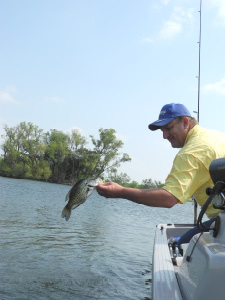
By Kenneth L. Kieser
Spring conditions produce excellent fishing for crappie on small lakes and ponds. Yet even the best laid plans can result in failure—sometimes desirable failure.
Steve Matt and I planned to use jigs to draw crappie from a 20-acre lake in Kansas. The lake was smooth early in the morning, making the use of light jigs do-able. Matt’s G-3 bass boat featured comfortable fishing chairs that made the experience even better. Even my big carcass didn’t rock the stable craft as I stood up to cast.
We dropped our 1/32-ounce Road Runner jigs around stumps and submerged brush, expecting a strike any second. Problem was, this technique didn’t draw a nibble after two passes—not even from a tiny bluegill. But we did catch big bass—on every cast.
We were both certain this technique would work if we could find the crappie while not taking into consideration that bass would hit the jigs before crappie had a chance. I was up the famous creek without a paddle because I had to write at least one crappie story for a magazine.
Light breezes drifted the boat toward a shallow eastern shore covered with moss. We both threw chartreuse Road Runners while quickening our retrieves to avoid dragging through weeds. Suddenly a sharp strike doubled my medium-action spinning rod and the fight was on.
“Another bass,” I quietly surmised, not entirely disappointed while enjoying the fight.
These bass in the cool lake water fought like wild animals.
We caught several in the three to four pound range that seemed much bigger.
I released my three pounder while Matt hooked one about the same size. Suddenly we had found a bonanza of bass—and on 1/32-ounce lures generally associated with crappie fishing. In fact, we drifted past a stretch of shoreline that produced a strike on every cast for almost a half hour. We landed numerous bass from 3 to 4 1/2 pounds, but no crappie.
We continued down shore to more promising stumps and did not get a crappie bite, but still, more bass and I am not complaining.
Later that morning I felt a sharp hit and line started pulling through my reel’s drag system. Clearly this was a bigger bass and running away. I hoped the light-weight hook would hold. The bass made several sharp runs. I could only hang on.
I was surprised at the pressure a Road Runner’s hook could take as the bass continued making slashing runs. Finally the bass started losing her fight, allowing me to lip land the 5-pound largemouth that would probably weigh close to 7 pounds by the spawning time as evidenced by her big head.
“Bass are opportunistic predators,” said Gene Gilliland, Central Region Fisheries Supervisor for the Oklahoma Department of Wildlife Conservation. “Small baits are often attractive to a bass, no matter how big the bass is.
Largemouths, especially, often focus in on certain size bait that is available. For example, if 3,000 2-inch minnows are around, they may feed only on that size, no matter what swims in front of their face.”
“Schooling bass chasing shad on the surface become very particular about the size of shad they are chasing,” Gilliland continued. “They may pass on a 3-inch shad for a 2-inch shad. The angler must figure out the preferred size that day. Two to 3-inch shad tends to be the optimum size for most bass.”
I caught additional bass on Beetle Spins. This little 1/32-ounce lure is a giant killer. Truthfully, the key to bass fishing is trying different techniques and lure sizes, shapes and colors. As always, let the bass tell you what they want.
Finally by morning’s end we found the crappie and caught several between bass strikes. For some reason the big bluegill started hitting. Many were easily over a pound, a tribute to the pond’s forage base that easily feeds this fabulous fishery.
“We have been instructed by fishery biologists to never remove bluegill from this pond,” Matt said. “They provide a constant source of food to the bigger predator fish. We have a baitfish base in here, too, so the food is plentiful. I would hate to be a minnow in this lake.”
The morning ended with a good mess of crappie and in fact, several smaller bass removed to lessen the forage consumption. The following day, bad weather moved in and Matt could only catch two bass. We caught over 100 the day before. Sometimes timing is everything!
Above, Steve Matt lands one of the crappie we finally caught. The aggressive bass made crappie fishing a challenge. Photo by Kenneth L. Kieser

















